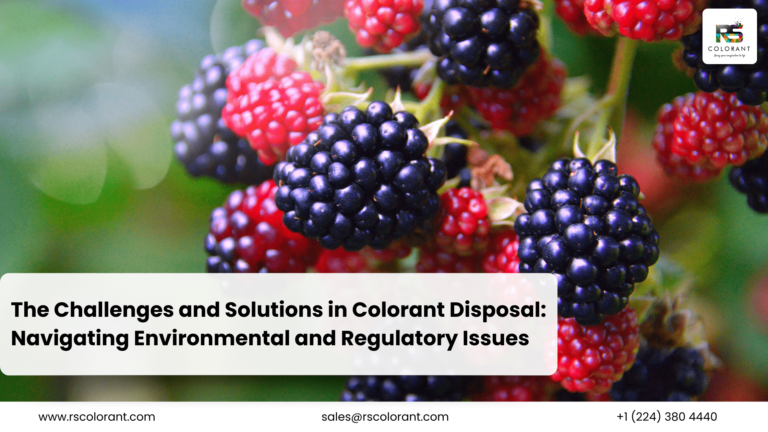The Future of Eco-Friendly Colorants
Introduction
In a world increasingly aware of environmental sustainability, eco-friendly colorants have become a focal point. These colorants, derived from natural sources, promise to reduce environmental impact and provide safer alternatives to synthetic dyes. As we look towards a greener future, the role of eco-friendly colorants becomes ever more significant.
The Evolution of Colorants
Historical Perspective
Colorants have been used since ancient times, with early humans using natural substances to dye fabrics, foods, and artworks. Over centuries, synthetic dyes were developed, offering a broader range of vibrant colors and greater stability. However, the environmental and health impacts of synthetic dyes have led to a resurgence in the use of natural, eco-friendly alternatives.
Transition from Synthetic to Natural Colorants
The shift from synthetic to natural colorants is driven by a growing awareness of the negative effects of synthetic dyes, such as pollution and toxicity. As technology advances, it becomes easier and more cost-effective to produce and use natural colorants, paving the way for their widespread adoption.
What Makes a Colorant Eco-Friendly?
Natural vs. Synthetic Colorants
Eco-friendly colorants are typically derived from natural sources like plants, minerals, animals, and microbes. Unlike synthetic dyes, which are often petroleum-based and can be harmful to the environment, natural colorants are biodegradable and less toxic.
Environmental Impact
Eco-friendly colorants minimize environmental damage by reducing pollution and conserving resources. They are often produced using sustainable methods that require fewer chemicals and generate less waste.
Health Benefits
Natural colorants are generally safer for human health. They reduce the risk of allergic reactions and other health issues associated with synthetic dyes, making them ideal for use in food, cosmetics, and textiles.
Types of Eco-Friendly Colorants
Plant-Based Colorants
Derived from various plants, these colorants offer a wide range of hues. Examples include indigo from the indigo plant and henna from the henna tree.
Mineral-Based Colorants
Mineral-based colorants are sourced from naturally occurring minerals. They provide earthy tones and are commonly used in cosmetics and paints.
Animal-Based Colorants
Some natural colorants are derived from animals, such as cochineal, a red dye obtained from insects. These colorants are less common due to ethical and sustainability concerns.
Microbial Colorants
Produced by microorganisms like bacteria and fungi, microbial colorants represent a growing field with significant potential. They can be produced sustainably and offer unique color properties.
Innovative Sources of Eco-Friendly Colorants
Algae
Algae are a promising source of eco-friendly colorants. They grow rapidly, require minimal resources, and can produce a variety of pigments.
Fungi
Fungi, including mushrooms and molds, can produce vibrant and stable colorants. They can be cultivated sustainably and offer an exciting avenue for research.
Bacteria
Certain bacteria can produce pigments through fermentation processes. This method is highly sustainable and can be scaled up for industrial applications.
Technological Advancements in Eco-Friendly Colorant Production
Biotechnological Methods
Advances in biotechnology enable the efficient production of natural colorants through processes like genetic engineering and fermentation. These methods improve yield and consistency.
Green Chemistry
Green chemistry focuses on designing products and processes that minimize environmental impact. This approach is crucial in developing eco-friendly colorants that are safe and sustainable.
Sustainable Harvesting Techniques
Sustainable harvesting ensures that natural sources of colorants are not depleted. Techniques such as crop rotation and organic farming play a vital role in this process.
Applications of Eco-Friendly Colorants
Food Industry
Natural colorants are widely used in the food industry to enhance the appearance of products. They provide a safer alternative to synthetic food dyes.
Textile Industry
The textile industry is a major consumer of colorants. Eco-friendly dyes are gaining popularity as consumers demand more sustainable fashion.
Cosmetic Industry
Natural colorants are preferred in cosmetics for their safety and skin-friendly properties. They are used in products ranging from lipsticks to eyeshadows.
Art and Design
Artists and designers are increasingly turning to eco-friendly colorants for their work. These colorants offer unique shades and contribute to sustainable practices in the arts.
Case Studies of Successful Eco-Friendly Colorant Implementations
Brands Leading the Way
Several brands are pioneering the use of eco-friendly colorants. For example, Patagonia uses natural dyes in its clothing line, while Lush incorporates them in its cosmetics.
Real-World Examples
In the textile industry, companies like Colorifix are using microbial colorants to dye fabrics sustainably. In the food industry, brands like Natural Food Colours are leading the way with plant-based dyes.
Challenges in the Adoption of Eco-Friendly Colorants
Cost Implications
Natural colorants can be more expensive than synthetic ones. However, as demand grows and production methods improve, costs are expected to decrease.
Scalability Issues
Producing natural colorants on a large scale can be challenging. Research and innovation are key to overcoming these scalability issues.
Consumer Awareness
Educating consumers about the benefits of eco-friendly colorants is crucial. Increased awareness can drive demand and support the transition to sustainable options.
Future Trends in Eco-Friendly Colorants
Innovations on the Horizon
Research is ongoing to discover new sources of natural colorants and improve existing ones. Innovations in biotechnology and green chemistry hold great promise for the future.
Predicted Market Growth
The market for eco-friendly colorants is expected to grow significantly. As more industries adopt sustainable practices, the demand for natural colorants will rise.
Potential Regulatory Changes
Governments worldwide are introducing regulations to encourage the use of eco-friendly colorants. These policies will further drive the market towards sustainability.
The Role of Consumers in Promoting Eco-Friendly Colorants
Consumer Choices and Demand
Consumers have the power to drive change by choosing products made with eco-friendly colorants. Increased demand will push manufacturers to adopt sustainable practices.
Impact of Consumer Behavior
Sustainable consumer behavior can lead to a significant reduction in environmental impact. By choosing eco-friendly products, consumers contribute to a greener future.
Government and Policy Influence
Current Regulations
Existing regulations in many countries promote the use of natural colorants, particularly in the food and cosmetic industries.
Future Policy Directions
Future policies are likely to further support the development and use of eco-friendly colorants, with an emphasis on sustainability and safety.
Environmental Impact of Eco-Friendly Colorants
Reduction in Pollution
Eco-friendly colorants reduce pollution by eliminating harmful chemicals used in synthetic dyes. This leads to cleaner air, water, and soil.
Biodiversity Benefits
Using natural colorants supports biodiversity by promoting sustainable agricultural practices and reducing the need for synthetic chemicals.
Health and Safety Benefits
Non-Toxic Nature
Natural colorants are typically non-toxic, making them safer for both humans and the environment. They reduce the risk of health issues associated with synthetic dyes.
Benefits for Sensitive Populations
Individuals with allergies or sensitivities to synthetic dyes benefit from the use of natural colorants. These colorants are gentler on the skin and less likely to cause adverse reactions.
Conclusion
The future of eco-friendly colorants is bright, with technological advancements and increased consumer awareness driving their adoption. By choosing sustainable options, we can reduce environmental impact and promote a healthier, safer world. The journey towards a greener future is ongoing, and eco-friendly colorants play a crucial role in this transformation.
FAQs
1. What are eco-friendly colorants?
Eco-friendly colorants are natural dyes derived from plants, minerals, animals, or microbes. They are biodegradable and less toxic than synthetic dyes.
2. How do eco-friendly colorants benefit the environment?
Eco-friendly colorants reduce pollution, conserve resources, and support biodiversity by eliminating harmful chemicals and promoting sustainable practices.
3. Are eco-friendly colorants more expensive?
Initially, eco-friendly colorants can be more expensive than synthetic dyes. However, as demand increases and production methods improve, costs are expected to decrease.
4. Can eco-friendly colorants be used in all industries?
Yes, eco-friendly colorants are versatile and can be used in various industries, including food, textiles, cosmetics, and art.
5. What is the future outlook for eco-friendly colorants?
The future of eco-friendly colorants is promising, with ongoing research and innovations driving market growth and adoption across industries.




